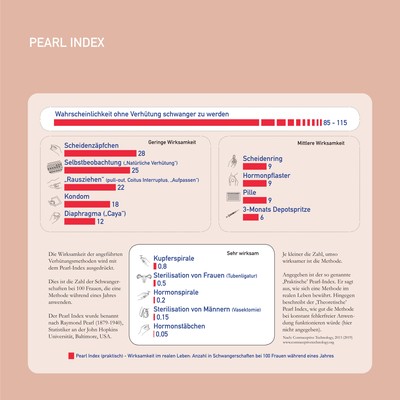The Pearl Index
The safety of contraceptive methods is indicated by the Pearl Index, which represents the number of failures (ie, unintended pregnancies) per 100 woman-years of exposure. The Pearl Index tells us how effective a contraceptive method is by measuring how many unintended pregnancies occur for every one hundred women-years of exposure (one hundred women using the method for one year): the smaller the number, the safer the method.
The “perfect use Pearl Index” provides an indication of how effective the method is in theory, but not of how safe it is in practice. Only the “actual use Pearl Index” tells us how women/couples get on with a particular method when using it on a day-to-day basis, so this is the number we need to ask about – because this is a better reflection of what happens in real life and often is therefore “not as pretty” as the perfect use Pearl Index.
Let’s look at condoms as an example: in the first year of use, there are five unintended pregnancies with “perfect use”, but for “actual use” the figure is 21. For natural family planning, based on periods of abstinence determined by self-observation of mucus, the “perfect use” rate is between 1 and 9 per cent, but in “actual use” 25 per cent of women who use this method find themselves unintentionally pregnant within the first year of use. The rate of unintended pregnancies falls as users become more experienced at using a particular method.
Read more on this subject in “Contraceptive Technology” by Robert A. Hatcher et al., Ardent Media, New York, 1998 (ISBN 0-9664902-0-7)
